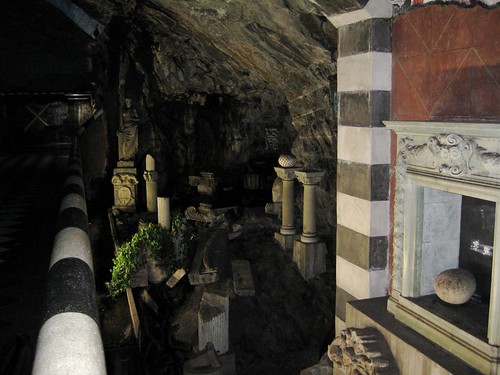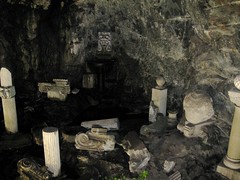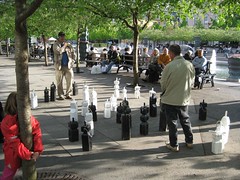Stockholm’s subway system is geologic, carved out of solid bedrock, with the rock left showing many places. This is from a little alcove in the entrance to the Kungsträdgården metro station in downtown Stockholm. Sorry for the poor lighting, but it’s the best I could do with the point-and-shoot’s built-in flash. It’s “ancient” ruins, seemingly uncovered as the metro was being built, an homage to our early European roots, I think. Here’s another angle.

Stockholm Chess
Thanks to the Inkstain posse for the suggestions for my Stockholm vacation itinerary. In particular Verbal and Dano – it had been rainy since I got to Stockholm (I didn’t mind) but the sun came out this afternoon, as did these two gentlemen in Kungstragaarden for a came of chess. And pretty much everyone else was out of doors as well.
Stockholm bike
Stockholm’s bicycling zeitgeist is extraordinarily pragmatic. Almost no spandex. Almost no fixies. Just a lot of bikes like this, with baskets and fenders and locks. Some really nice locks. The people riding the bikes look far more pragmatic, too, like a cross section of the population. Good bike lanes and, in some cases, separated trails in the part of the city I’ve seen thus far.
I got in around midday after one of those overnight transatlantic flights. (Rather like a big, uncomfortable campout with 250 strangers.) Slept little, so to fight off jet lag and try to reset my circadian thingamabob, I spent the afternoon wandering around the city, mostly taking pictures of bikes and other things. I’m here for an environmental journalism workshop organized by the Swedish Institute and others, bringing together journalists from the United States and Europe to talk about what we do and how we do it. I’m especially interested in learning about European environmental issues, and Swedish issues in particular, which are a far cry from the arid southwestern issues I spend my work days thinking about. (It rained on a good part of this afternoon’s walkabout. They have lakes – regular ones tha don’t need a dam at one end to hold the water up.)
Sweden has one of the lower per capita greenhouse gas emission rates in the developed world. There’s a storytelling riff in here for the taking about the sea of bikes outside the Central Train Station next door to my hotel. But, truth be told, I’ve no idea whether bike ridership here is higher than in other parts of the developed world. No doubt, though, that it’s higher than in Albuquerque.
California’s Delta Dilemma
The Sacramento Delta is a classic example of government’s ability to kick the can down the road. Mike Taugher has a nice overview today of the current state of play:
At least a couple of recent studies suggest California has, in recent years, bumped up against the upper limit of what it can take from the delta, and that the state’s farms and cities may have to get by with less.
One solution, according to state government and many of the state’s water agencies, is an initiative that seeks to revive the idea of building the peripheral canal, a highly controversial aqueduct around the delta that voters rejected in 1982. It would cost water users and taxpayers billions of dollars, and even then, it is possible cities and farms might not get more water, at least in dry years, as some experts contend.
Kafkaesque
When I was a senior in high school, some friends and I had a campus club that, among other wholesome activities, held a Franz Kafka Lookalike contest. I won, though the results were always a bit suspect. (We had no picture of Kafka, and thus had no idea what he looked like.)
For my birthday last week, daughter Nora gave me a Franz Kafka refrigerator magnet/finger puppet. I think the resemblance is striking, don’t you?
Belshaw on Bryan Patterson’s Graduation
Bryan Patterson, whose struggle to recover from brain injury my colleague Jim Belshaw chronicled in the Albuquerque Journal, graduated from UNM today with a masters degree in public health, and Jim was there to enjoy the moment:
I had an aisle seat and I could see him when he made the turn into the aisle. When our eyes met, we smiled. By the time he reached me and held out a hand, all we could was laugh. No words came. Only laughter at the disbelieving wonder of it all.
That he could walk was miraculous enough. That he was alive to walk even more so. By rights, by any reasonable medical assessment, Bryan should not have been in the building, should not have been alive, let alone the recipient of a master’s degree in public health.
Groundwater Regulation in California (or lack thereof)
Here in New Mexico, groundwater is regulated – sort of. If you’re a big municipality that pumps a lot, for example, you can be required to buy up surface water rights to replace the water that inevitably seeps from the rivers down to replace that which you have pumped. It’s not really regulating groundwater directly, but it helps.
In California, not so much, as Felicity Barranger reports in the New York Times today:
If he lived in almost any other state in the arid Southwest, Mr. Watte could be required to report his withdrawals of groundwater or even reduce them. But to California’s farmers and developers, that is anathema. “I don’t want the government to come in and dictate to us, ‘This is all the water you can use on your own land,’ ” said Mr. Watte, 57. “We would resist that to our dying day.”
Although California has been a pathbreaker in some environmental arenas, like embracing renewable energy and recycling, groundwater rights remain sacrosanct. But the state government is facing growing pressure to embrace regulation.
Stockholm
I have the opportunity to visit the old European city of Stockholm later this month for an interesting workshop (more on this later) and I’ve managed to build in a few extra days to play. Any suggestions on things to see?
Cavendish
I know the whole sports hero thing is dangerous, especially in bike racing, so let’s just leave it at this: it’s fun to watch this kid ride a bike:
Baseball on a Sunny Sunday Afternoon
It was a sunny Sunday afternoon in August, 1990, that Lissa and I saw our first baseball game in Albuquerque. We had flown in on an apartment-hunting trip before our move, and once we had things nailed down, we headed out to the ballpark to catch a game.
We both grew up in LA, as Dodger fans. The Dukes were the Dodgers’ top farm team, so it was an easy fit. We already knew about the lava beyond the outfield wall (though, hearing Vin Scully tell it, I always imagined a stadium on the edge of a volcano, not a bunch of lava rocks trucked in and piled on a gravel berm).
Nora and I took Lissa out to the park this afternoon for Mother’s Day, and it was as fine a day as the baseball gods could ever have provided. The Isotopes, successor to the Dukes we watched that summer day 19 years ago, are back in Dodger blue, and all seemed right with the world.
There is nothing quite like a warm summer’s day spent watching minor league baseball. AAA ball is high quality, but a bit more wild and unpredictable than the major leagues.
The game offered up one of those strangely quirky plays that left me scratching my head as I filled out the scorecard: a 4-9-6 putout. Runner on first, batter pops to short right, near the foul line. Runner holds, thinking the second baseman, racing over, is going to catch it. But it glances off the second baseman’s glove (4), bounding over to the right fielder (9) who makes the throw to the shortstop (6) covering second for the force.
There were an unusually large number of people in giant animal costumes marketing, among other things, a company that will fix your rain gutters (a duck of some sort), and the traditional greeting of two Little League teams (the kids get to run out onto the field and stand with their Isotope counterpart for the singing of our national anthem). They cut short the traditional playing of YMCA during the 7th inning stretch (too gay?), but at least we got one chorus in.
And the ballpark has a real organist.




